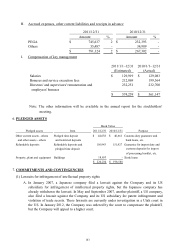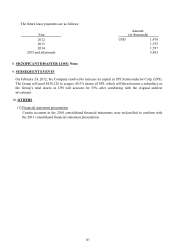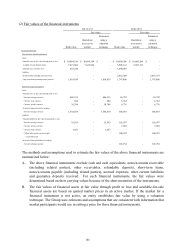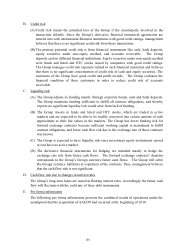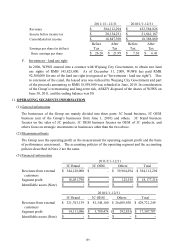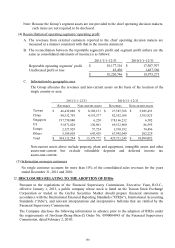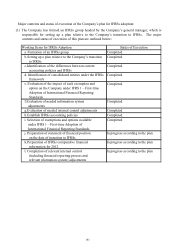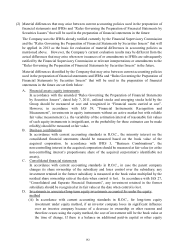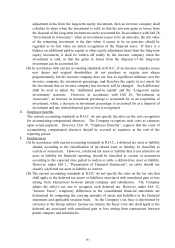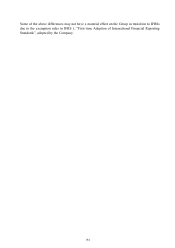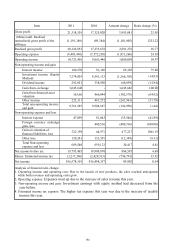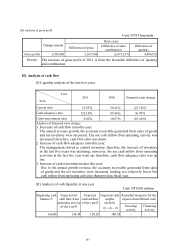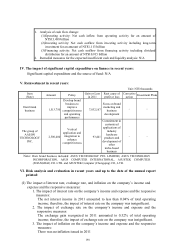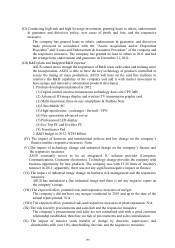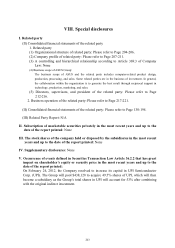Asus 2011 Annual Report Download - page 197
Download and view the complete annual report
Please find page 197 of the 2011 Asus annual report below. You can navigate through the pages in the report by either clicking on the pages listed below, or by using the keyword search tool below to find specific information within the annual report.
193
~65~
adjustment items from the long-term equity investment, then an investor company shall
calculate its share when the investment is sold, so that the pro-rata gains or losses from
the disposal of the long-term investment can be accounted for. In accordance with IAS 28,
“Investments in Associates”, when an investment ceases to be an associate, the fair value
of the remaining investment at the date when it ceases to be an associate should be
regarded as its fair value on initial recognition of the financial asset. If there is a
balance on additional paid-in capital or other equity adjustment items from the long-term
equity investment, it shall be written off totally by the investor company when the
investment is sold, so that the gains or losses from the disposal of the long-term
investment can be accounted for.
(B) In accordance with current accounting standards in R.O.C., if an investee company issues
new shares and original shareholders do not purchase or acquire new shares
proportionately, but the investor company does not lose its significant influence over the
investee company, the investment percentage, and therefore the equity in net assets for
the investment that an investor company has invested, will be changed. Such difference
shall be used to adjust the ‘Additional paid-in capital’ and the ‘Long-term equity
investments’ accounts. However, in accordance with IAS 28, “Investments in
Associates”, an increase in investment percentage is accounted for as an acquisition of
investment; while, a decrease in investment percentage is accounted for as a disposal of
investment and any related disposal gain or loss is recognized.
E. Employee benefits
The current accounting standards in R.O.C. do not specify the rules on the cost recognition
for accumulating compensated absences. The Company recognizes such costs as expenses
upon actual payment. However, IAS 19, “Employee Benefits”, requires that the costs of
accumulating compensated absences should be accrued as expenses at the end of the
reporting period.
F. Income taxes
(A) In accordance with current accounting standards in R.O.C., a deferred tax asset or liability
should, according to the classification of its related asset or liability, be classified as
current or noncurrent. However, a deferred tax asset or liability that is not related to an
asset or liability for financial reporting, should be classified as current or noncurrent
according to the expected time period to realize or settle a deferred tax asset or liability.
However, under IAS 1, “Presentation of Financial Statements”, an entity should not
classify a deferred tax asset or liability as current.
(B) The current accounting standards in R.O.C do not specify the rules on the tax rate that
shall apply to the deferred tax assets or liabilities associated with unrealized gain or loss
arising from transactions between parent company and subsidiaries. The Company
adopts the seller’s tax rate to recognize such deferred tax. However, under IAS 12,
“Income Taxes”, temporary differences in the consolidated financial statements are
determined by comparing the carrying amounts of assets and liabilities in the financial
statements and applicable taxation basis. As the Company’s tax base is determined by
reference to the Group entities’ income tax returns, the buyer’s tax rate shall apply to the
deferred tax associated with unrealized gain or loss arising from transactions between
parent company and subsidiaries.


